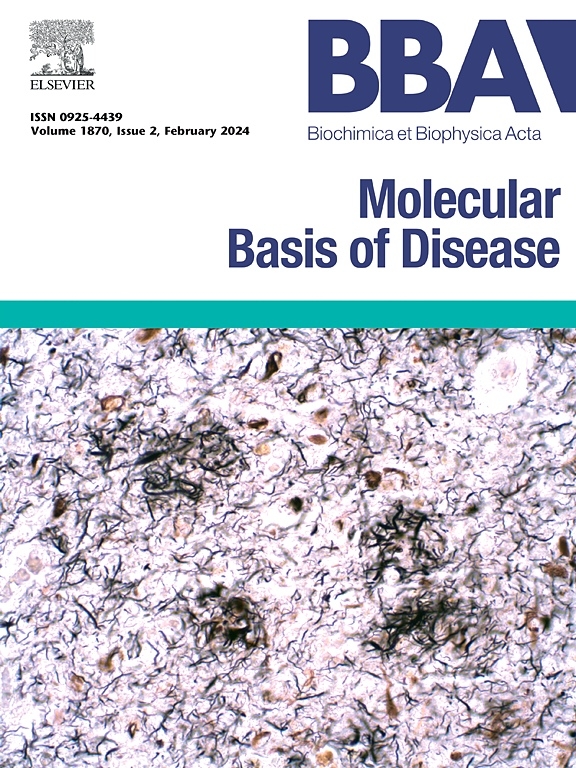DLX1-NCS1-MYC轴驱动肺腺癌的发生和进展
IF 4.2
2区 生物学
Q2 BIOCHEMISTRY & MOLECULAR BIOLOGY
Biochimica et biophysica acta. Molecular basis of disease
Pub Date : 2025-07-03
DOI:10.1016/j.bbadis.2025.167967
引用次数: 0
摘要
肺腺癌(LUAD)仍然是全球癌症相关死亡的主要原因,但其进展的转录驱动因素尚未完全阐明。在这里,我们发现DLX1,一种新的同源盒转录因子,在LUAD中是一个关键的致癌调节因子。rna测序和微阵列数据集的整合转录组学分析显示,与正常肺相比,LUAD组织中的DLX1显着过表达,这一发现在包括癌症基因组图谱(TCGA)和TIMER在内的独立数据集中得到了验证。DLX1表达升高与晚期临床分期、TP53突变和较差的总生存率相关。功能研究强调DLX1在LUAD肿瘤发生中的重要作用。沉默DLX1会在体外损害细胞增殖、侵袭和集落形成,同时在体内显著抑制肿瘤生长。在机制上,转录组学分析结合基因集富集分析(GSEA)确定DLX1是myc驱动的致癌途径的调节因子。重要的是,NCS1被发现是DLX1的直接转录靶点。染色质免疫沉淀(ChIP)和荧光素酶分析表明,DLX1结合NCS1启动子内的两个保守基序,驱动其转录激活。在功能上,NCS1恢复了dlx1缺陷LUAD细胞的增殖和侵袭特性,确立了其作为dlx1依赖性致癌性介质的作用。此外,NCS1本身作为c-MYC的上游调节因子,在LUAD中显著上调,其表达与晚期、TP53突变和不利的临床结果相关。总的来说,我们的研究结果描述了DLX1-NCS1-MYC轴是支持LUAD进展的关键转录网络。本文章由计算机程序翻译,如有差异,请以英文原文为准。
The DLX1-NCS1-MYC axis drives oncogenesis and progression in lung adenocarcinoma
Lung adenocarcinoma (LUAD) remains the leading cause of cancer-related mortality globally, yet the transcriptional drivers of its progression are incompletely elucidated. Here, we identify DLX1, a novel homeobox transcription factor, as a pivotal oncogenic regulator in LUAD. Integrative transcriptomic analyses of RNA-sequencing and microarray datasets reveal significant overexpression of DLX1 in LUAD tissues compared to normal lung, a finding validated across independent datasets including The Cancer Genome Atlas (TCGA) and TIMER. Elevated DLX1 expression is associated with advanced clinical stages, TP53 mutations, and poor overall survival. Functional studies underscore the essential role of DLX1 in LUAD tumorigenesis. Silencing DLX1 impairs cell proliferation, invasion, and colony formation in vitro while significantly suppressing tumor growth in vivo. Mechanistically, transcriptomic profiling coupled with Gene Set Enrichment Analysis (GSEA) identifies DLX1 as a regulator of MYC-driven oncogenic pathways. Importantly, NCS1 is uncovered as a direct transcriptional target of DLX1. Chromatin immunoprecipitation (ChIP) and luciferase assays demonstrate that DLX1 binds two conserved motifs within the NCS1 promoter, driving its transcriptional activation. Functionally, NCS1 restores proliferative and invasive properties in DLX1-deficient LUAD cells, establishing its role as a mediator of DLX1-dependent oncogenicity. Furthermore, NCS1 itself acts as an upstream regulator of c-MYC and is significantly upregulated in LUAD, with its expression correlating with advanced stages, TP53 mutations, and unfavorable clinical outcomes. Collectively, our findings delineate the DLX1-NCS1-MYC axis as a critical transcriptional network underpinning LUAD progression.
求助全文
通过发布文献求助,成功后即可免费获取论文全文。
去求助
来源期刊
CiteScore
12.30
自引率
0.00%
发文量
218
审稿时长
32 days
期刊介绍:
BBA Molecular Basis of Disease addresses the biochemistry and molecular genetics of disease processes and models of human disease. This journal covers aspects of aging, cancer, metabolic-, neurological-, and immunological-based disease. Manuscripts focused on using animal models to elucidate biochemical and mechanistic insight in each of these conditions, are particularly encouraged. Manuscripts should emphasize the underlying mechanisms of disease pathways and provide novel contributions to the understanding and/or treatment of these disorders. Highly descriptive and method development submissions may be declined without full review. The submission of uninvited reviews to BBA - Molecular Basis of Disease is strongly discouraged, and any such uninvited review should be accompanied by a coverletter outlining the compelling reasons why the review should be considered.

 求助内容:
求助内容: 应助结果提醒方式:
应助结果提醒方式:


